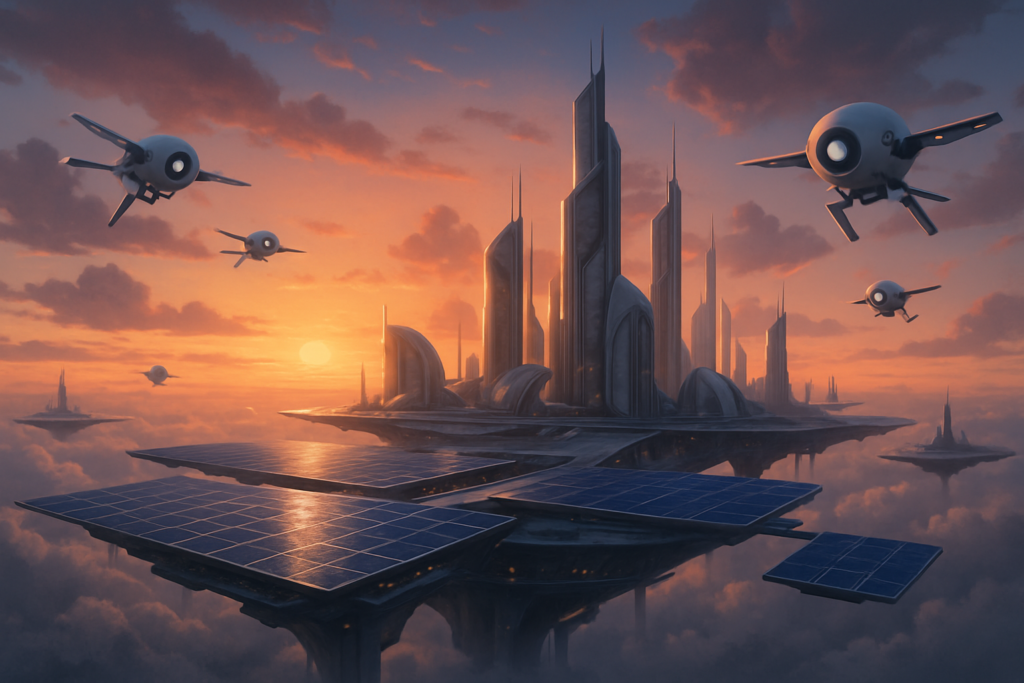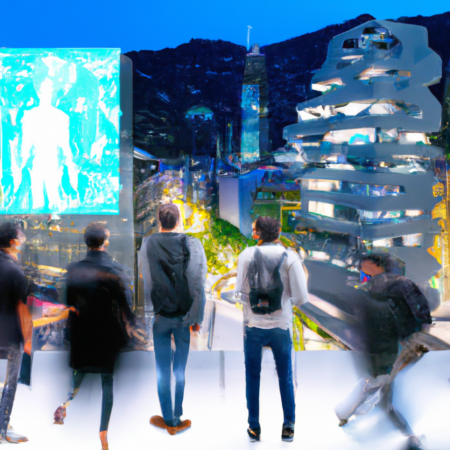Floating cities may sound like science fiction, but with advancements in light-weight materials, anti-gravity propulsion theories, and sustainable energy, the idea is inching closer to plausible.
Inspired by concepts from anime like Laputa and real-world innovations in lighter-than-air technology, future metropolises might orbit in the stratosphere — offering clean air, infinite solar power, and panoramic views of Earth.
These structures would be managed by decentralized AI, connected by aerial tunnels, and rely on algae-based bio-habitats for air and water recycling. Think of them as permanent skyships — a hybrid of space station and city.
Sounds wild? Maybe. But then again, so did the internet in 1970.
Throughout human history, our cities have always been bound to the Earth. From the early days of river civilizations to today’s concrete jungles, we’ve stacked higher, spread wider, and burrowed deeper — but always on the ground. But what if we didn’t have to?
What if the cities of tomorrow weren’t tied to land at all?
Imagine looking up and seeing vast floating platforms, alive with lights and movement, drifting like clouds — not science fiction, but an actual, engineered future. Welcome to the era of floating cities — where urban living levitates above the Earth.
☁️ Why Float at All?
At first glance, the idea of a sky city sounds like pure fantasy — something from Star Wars, Bioshock, or the floating island of Laputa in Castle in the Sky. But dig a little deeper, and the question turns from “why?” to “why not?”
🔥 Climate Pressure
With rising sea levels, extreme heat, and collapsing infrastructure in flood-prone cities, living on land is becoming increasingly risky. Floating cities avoid these risks by rising above them — quite literally.
🌿 Reclaiming the Earth
By moving dense populations into the sky, we free up Earth’s surface for reforestation, agriculture, and ecosystem restoration. Think of it as giving the planet room to breathe again.
🌞 Infinite Energy
The skies offer unmatched solar exposure. Floating cities, especially those in the stratosphere, could operate almost entirely off-grid, powered by solar arrays above the clouds.
🏙️ The Tech Behind It
So how do you make a city float? Here are some of the emerging (and theoretical) technologies involved:
🪶 1. Lighter-Than-Air Structures
We already know how to float things: balloons, blimps, zeppelins. Replace rubber and fabric with advanced carbon fiber or graphene shells, and you have scalable floating platforms. Companies like LTA Research, backed by Google co-founder Sergey Brin, are exploring cargo-scale airships today.
🧲 2. Magneto-Gravitational Systems
This one’s a bit out there, but experimental propulsion systems using diamagnetic levitation and superconducting magnets could eventually provide stable lift without fuel.
🔋 3. Stratospheric Platforms (HAPS)
High-Altitude Platform Stations (HAPS) are already being tested for surveillance and communication. Imagine turning those into habitable habitats — think “hovering cities” 20 km above Earth.
🤖 4. AI Urban Management
Floating cities require surgical precision. From stabilization to oxygen recycling, artificial intelligence would handle:
- Wind compensation
- Microclimate control
- Population flow
- Energy grid optimization
- Food & waste logistics
🏗️ How Would People Live?
Designing a floating city requires more than floating. It needs to function. That means:
🌇 Architecture
No concrete jungles here — buildings would be featherweight, modular, and vertical. Materials like aerogels, carbon composites, and transparent aluminum would become the new standard.
🛫 Transportation
Forget cars. Think AI-managed drones, personal sky pods, and high-speed magnetic tunnels connecting platform to platform.
🌬️ Air & Water
Atmospheric water generators could harvest moisture from the air. Algae bio-reactors would purify CO₂ and generate oxygen. Waste would be compacted, recycled, or ejected to Earth processing stations.
🍅 Food
Rooftop hydroponics, aeroponics, and vertical farms would dominate. You’d be eating strawberries grown next to a turbine, powered by the sun above and purified air all around.
🎨 What Would It Look Like?
Now the fun part — the visuals.
Picture this:
A golden sunset paints the underside of a vast city suspended by elegant, rotating disks. Towering spires glisten with solar panels. Swarms of drones hum quietly, zipping packages and passengers between districts. Transparent skywalks connect floating plazas. Gravity feels optional.
People walk calmly through botanical corridors — half-urban, half-forest. The horizon? Nothing but clouds, stars, and sky.
(DALL·E prompt: “A futuristic city floating in the sky, with solar panels, AI drones flying around, connected platforms, sunset background, ultra-modern architecture — concept art style”)
🤯 Real Projects Already in Motion
This isn’t just imagination:
- Oceanix City (UN-backed): While sea-based, it’s a stepping stone to atmospheric platforms.
- Jetson ONE: Personal flight is already a consumer product.
- Zephyr by Airbus: Solar-powered atmospheric platforms that stay airborne for weeks.
⚠️ Challenges Ahead
Sure, it sounds amazing — but let’s not float too high just yet.
🌪️ Turbulence & Weather
Even in the stratosphere, atmospheric pressure, wind, and radiation are major hurdles. You’d need constant stabilization.
💸 Cost
These cities will cost billions — at first. But then again, so did skyscrapers and cell towers in their early days.
🧬 Health & Psychology
Would humans adapt well to thinner air, zero-gravity, and life without “grounding”? Long-term studies are needed.
🚀 Why This Matters (Even If It’s 100 Years Off)
Floating cities symbolize something bigger: a mindset shift.
They ask:
- What if we stopped expanding outward and started expanding upward?
- What if nature and urbanization could finally separate — and both thrive?
Whether we see them in 50 years or 150, the concept forces us to rethink architecture, sustainability, and what it means to live in harmony with the planet — even when we’re not standing on it.
✨ Final Thought
What if cities floated in the sky?
It’s not just a sci-fi fantasy anymore — it’s a possible future that blends innovation, sustainability, and imagination. And in a world drowning in problems, maybe it’s time we start looking up.






